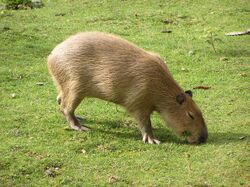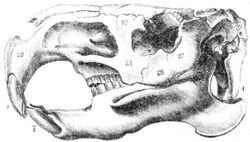Biology:Hystricomorpha
| Hystricomorpha Temporal range: Eocene to recent,
| |
|---|---|

| |
| Capybara | |
| Scientific classification | |
| Domain: | Eukaryota |
| Kingdom: | Animalia |
| Phylum: | Chordata |
| Class: | Mammalia |
| Order: | Rodentia |
| Suborder: | Hystricomorpha Brandt, 1855[1] |
| Superfamilies | |
|
See text | |
| Synonyms | |
|
Caviomorpha | |
The term Hystricomorpha (from Greek ὕστριξ, hystrix 'porcupine' and Greek μορφή, morphē 'form')[2] has had many definitions throughout its history. In the broadest sense, it refers to any rodent (except dipodoids) with a hystricomorphous zygomasseteric system. This includes the Hystricognathi, Ctenodactylidae, Anomaluridae, and Pedetidae. Molecular and morphological results suggest the inclusion of the Anomaluridae and Pedetidae in Hystricomorpha may be suspect. Based on Carleton & Musser 2005, these two families are discussed here as representing a distinct suborder Anomaluromorpha.
Classification

The modern definition of Hystricomorpha, also known as Entodacrya or Ctenohystrica, is a taxonomic hypothesis uniting the gundis with the hystricognath rodents.[3] Considerable morphological and strong molecular support exists for this relationship. If true, this hypothesis renders the traditional view of Sciurognathi invalid, as it becomes a paraphyletic group.
The hystricomorph rodents, or at least members of Caviomorpha, are sometimes not regarded as rodents.[4] Most molecular and genetic research, however, confirms the monophyly of rodents.[5] Support for rodent polyphyly appears to be a product of long branch attraction.[6]
Hystricomorph rodents appeared in South America in the Eocene,[7] a continent which previously had metatherians, xenarthrans, and meridiungulates as the only resident nonflying mammals[citation needed]. They apparently arrived by rafting across the Atlantic from Africa. The same type of migration may have occurred with primates,[8] which also appeared in South America in the Eocene when it was an isolated continent, long before the Great American Interchange. All of this is still controversial, and new scientific discoveries on this subject are published regularly.
Families
The following list of families is based on the taxonomy of Marivaux et al. 2002 and Marivaux, Vianey-Liaud & Jaeger 2004, who subjected a number of early fossil rodents to parsimony analysis and recovered support for the Hystricomorpha or Entodacrya hypothesis. Their results rendered the suborder Sciuravida as defined by McKenna & Bell 1997 to be polyphyletic and invalid. The symbol "†" is used to indicate extinct groups.
- Suborder Hystricomorpha
- Superfamily Ctenodactyloidea
- †Chapattimyidae
- Ctenodactylidae – gundis
- Diatomyidae – Laotian rock rat
- †Tamquammyidae
- †Yuomyidae
- Hystricognathiformes
- †Tsaganomyidae
- Hystricognathi – true hystricognaths
- †Baluchimyinae
- Phiomorpha
- Bathyergidae – blesmols
- †Bathyergoididae
- †Diamantomyidae
- Hystricidae – Old World porcupines
- †Kenyamyidae
- †Myophiomyidae
- Petromuridae – dassie rat
- †Phiomyidae
- Thryonomyidae – cane rats
- Caviomorpha – New World hystricognaths
- Superfamily Cavioidea
- Caviidae – cavies, capybaras, and guinea pigs
- †Cephalomyidae
- Cuniculidae – pacas
- Dasyproctidae – agoutis and acouchis
- Dinomyidae – pacarana
- †Eocardiidae
- †Neoepiblemidae
- Superfamily Chinchilloidea
- Abrocomidae – chinchilla rats
- Chinchillidae – chinchillas and viscachas
- Superfamily Erethizontoidea
- Erethizontidae – New World porcupines
- Superfamily Octodontoidea
- Capromyidae – hutias
- Ctenomyidae – tuco-tucos
- Echimyidae – spiny rats
- †Heptaxodontidae – giant hutias
- Myocastoridae – nutria
- Octodontidae – degus and relatives
- Superfamily Cavioidea
- Superfamily Ctenodactyloidea
Citations
- ↑ Brandt 1855
- ↑ "Hystricomorpha". Oxford Dictionaries. http://oxforddictionaries.com/definition/Hystricomorpha.
- ↑ Carleton & Musser 2005
- ↑ Graur, Hide & Li 1991; D'Erchia et al. 1996; Reyes, Pesole & Saccone 2000
- ↑ Cao et al. 1994; Kuma & Miyata 1994; Sullivan & Swofford 1997; Robinson-Rechavi, Ponger & Mouchiroud 2000; Lin et al. 2002; Reyes et al. 2004
- ↑ Bergsten 2005
- ↑ Antoine, P.-O.; Marivaux, L.; Croft, D. A.; Billet, G.; Ganerod, M.; Jaramillo, C.; Martin, T.; Orliac, M. J. et al. (2011). "Middle Eocene rodents from Peruvian Amazonia reveal the pattern and timing of caviomorph origins and biogeography". Proceedings of the Royal Society B: Biological Sciences 279 (1732): 1319–1326. doi:10.1098/rspb.2011.1732. PMID 21993503.
- ↑ Bond, M.; Tejedor, M. F.; Campbell, K. E.; Chornogubsky, L.; Novo, N.; Goin, F. (2015-02-04). "Eocene primates of South America and the African origins of New World monkeys". Nature 520 (7548): 538–41. doi:10.1038/nature14120. PMID 25652825.
General references
- Bergsten, J. (2005). "A review of long-branch attraction". Cladistics 21 (2): 163–193. doi:10.1111/j.1096-0031.2005.00059.x.
- Brandt, J. F. (1855) (in de). Beitrage zur nahern Kenntniss der Saugethiere Russlands.
- Cao, Y.; Adachi, J.; Yano, T.; Hasegawa, M. (1994). "Phylogenetic place of guinea pigs: No support of the rodent-polyphyly hypothesis from maximum-likelihood analyses of multiple protein sequences". Molecular Biology and Evolution 11 (4): 593–604. doi:10.1093/oxfordjournals.molbev.a040139. PMID 8078399.
- Carleton, M. D.; Musser, G. G. (2005). "Order Rodentia". in Wilson, D. E.; Reeder, D. M.. Mammal Species of the World A Taxonomic and Geographic Reference. Baltimore: Johns Hopkins University Press. pp. 745–752. ISBN 978-0-8018-8221-0.
- D'Erchia, A.; Gissi, C.; Pesole, G.; Saccone, C.; Arnason, U. (1996). "The guinea-pig is not a rodent". Nature 381 (6583): 597–600. doi:10.1038/381597a0. PMID 8637593.
- Flynn, J. J.; Wyss, A. R.; Croft, D. A.; Charrier, R. (2003). "The Tinguiririca Fauna, Chile: biochronology, paleoecology, biogeography, and a new earliest Oligocene South American Land Mammal 'Age'". Palaeogeography, Palaeoclimatology, Palaeoecology (Elsevier) 195 (3–4): 229–259. doi:10.1016/S0031-0182(03)00360-2. ISSN 0031-0182.
- Graur, D.; Hide, W.; Li, W. (1991). "Is the guinea-pig a rodent?". Nature 351 (6328): 649–652. doi:10.1038/351649a0. PMID 2052090.
- Lin, Y.-H.; McLenachan, P. A.; Gore, A. R.; Phillips, M. J.; Ota, R.; Hendy, M. D.; Penny, D. (2002). "Four new mitochondrial genomes and the increased stability of evolutionary trees of mammals from improved taxon sampling". Molecular Biology and Evolution 19 (12): 2060–2070. doi:10.1093/oxfordjournals.molbev.a004031. PMID 12446798.
- Marivaux, L.; Vianey-Liaud, M.; Jaeger, J.-J. (2004). "High-level phylogeny of early Tertiary rodents: dental evidence". Zoological Journal of the Linnean Society 142 (1): 105–134. doi:10.1111/j.1096-3642.2004.00131.x.
- Marivaux, L.; Welcomme, J.-L.; Vianey-Liaud, M.; Jaeger, J.-J. (2002). "The role of Asia in the origin and diversification of hystricognathous rodents". Zoologica Scripta 31 (3): 225–239. doi:10.1046/j.1463-6409.2002.00074.x.
- McKenna, M. C.; Bell, S. K. (1997). Classification of Mammals Above the Species Level. New York: Columbia University Press. ISBN 0-231-11013-8.
- Reyes, A.; Pesole, G.; Saccone, C. (2000). "Long-branch attraction phenomenon and the impact of among-site rate variation on rodent phylogeny". Gene 259 (1–2): 177–187. doi:10.1016/S0378-1119(00)00438-8. PMID 11163975.
- Reyes, A.; Gissi, C.; Catzeflis, F.; Nevo, E.; Pesole, G.; Saccone, C. (2004). "Congruent mammalian trees from mitochondrial and nuclear genes using Bayesian methods". Molecular Biology and Evolution 21 (2): 397–403. doi:10.1093/molbev/msh033. PMID 14660685.
- Robinson-Rechavi, M.; Ponger, L.; Mouchiroud, D. (2000). "Nuclear gene LCAT supports rodent monophyly". Molecular Biology and Evolution 17 (9): 1410–1412. doi:10.1093/oxfordjournals.molbev.a026424. ISSN 0737-4038. PMID 10960041.
- Sullivan, J.; Swofford, D. L. (1997). "Are Guinea Pigs Rodents? The Importance of Adequate Models in Molecular Phylogenetics". Journal of Mammalian Evolution 4 (2): 77–86. doi:10.1023/A:1027314112438. ISSN 1064-7554. http://www.webpages.uidaho.edu/~jacks/GuineaPig.pdf.
Wikidata ☰ Q532250 entry
th:เม่น
 |
